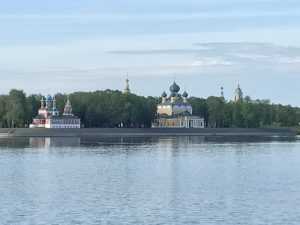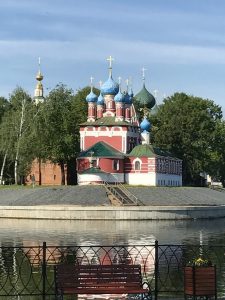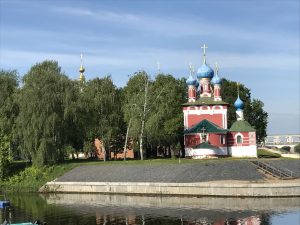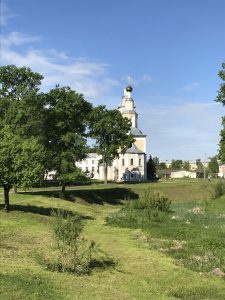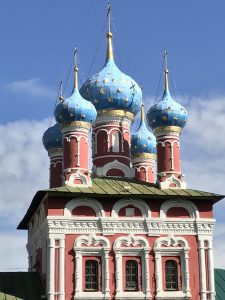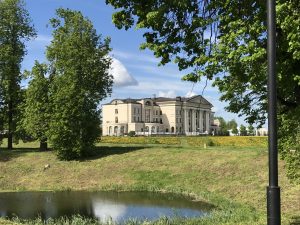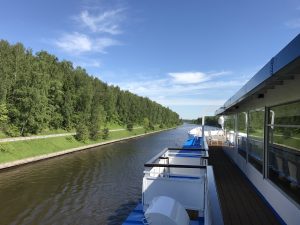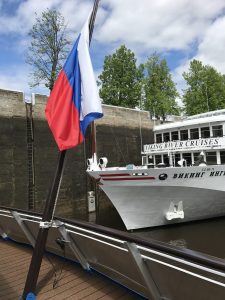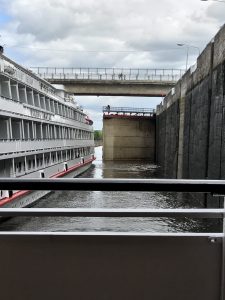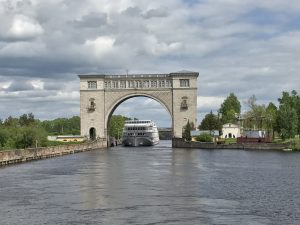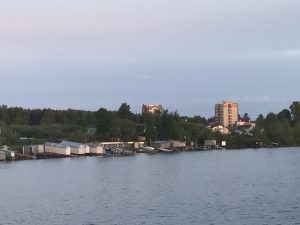Imperial Waterways of Russia
Thursday, June 8
Uglich
We got up early to get read for Uglich, another twon we hadn’t heard of before we started planning for this trip. Uglich, as it turns out, is the town associated with Boris Gudonov and the death of Tsarevitch Dmitry. Today it’s a small quiet town on the Volga, historically important, and part of the Moscow Golden Ring of yore. My guess is it’s about the size of Jasper, or maybe Selma.
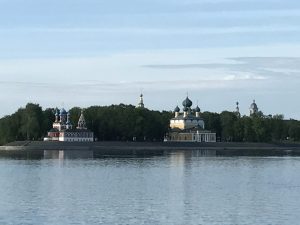 I have to say it’s probably the most attractive approach to a town we saw on this whole cruise. No doubt arriving on a clear morning, with the sun hitting the many churches across from the dock, didn’t hurt that impression. It was truly a striking view.
I have to say it’s probably the most attractive approach to a town we saw on this whole cruise. No doubt arriving on a clear morning, with the sun hitting the many churches across from the dock, didn’t hurt that impression. It was truly a striking view.
Judy and I avoided signing up for the power walking tour—a group that would walk to the nearby dam and power station that is now a museum—and cruised along with our small group through the phalanx of souvenir stalls linking the walkway. A nice variety, including several painters selling some very attractive watercolors, the inevitable t-shirts, and even a lot of antique odds and ends. Several of those things could have come from the smoke house at Cook Hill.
I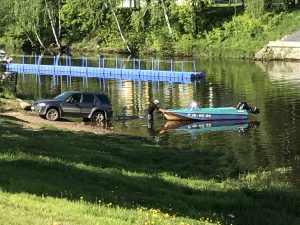 t was clear from our walk, and gawking up and down the streets as we walked, that although tourists were important to the local economy, we were not the only game in town. We heard about some industry there, but didn’t see any direct evidence in terms of factories or anything like that. Some nice older homes, though, and that was a neat reminder that we were in a real town, not just a showplace. And when you see someone wading in the shallows, launching a boat from his SUV, you know you’re not looking at tourists.
t was clear from our walk, and gawking up and down the streets as we walked, that although tourists were important to the local economy, we were not the only game in town. We heard about some industry there, but didn’t see any direct evidence in terms of factories or anything like that. Some nice older homes, though, and that was a neat reminder that we were in a real town, not just a showplace. And when you see someone wading in the shallows, launching a boat from his SUV, you know you’re not looking at tourists.
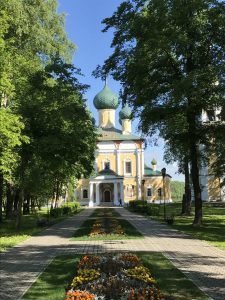 We crossed a bridge and walked onto the grounds of the former Kremlin here, now a well-maintained park area with more than a few churches and former churches. We were ushered into one of those that is now a performance and exhibition venue to hear the local Uglich choir. This time there were five singers, and they were joined on one number by the largest balalaika I’ve ever seen and a squeeze box. Now that was fun. We weren’t told not to record this time, so I got a couple of videos, but they’re just excerpts. They’ll be at the bottom of this page, before the photos.
We crossed a bridge and walked onto the grounds of the former Kremlin here, now a well-maintained park area with more than a few churches and former churches. We were ushered into one of those that is now a performance and exhibition venue to hear the local Uglich choir. This time there were five singers, and they were joined on one number by the largest balalaika I’ve ever seen and a squeeze box. Now that was fun. We weren’t told not to record this time, so I got a couple of videos, but they’re just excerpts. They’ll be at the bottom of this page, before the photos.
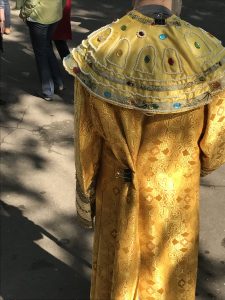 We next did something unusual for this trip: we stood in our separate walking groups with our guides for a group photo made by the ship photographers. There was a young guy in a traditional outfit to pose with each group, and I couldn’t help noticing that he was exactly wearing period footwear. Those shoes looked a lot like a pair of old Keds. It was real easy to smile for the photographer, though, because when we stood behind in in our group, I spotted the large binder clip that was holding the waist of his costume together. It was large enough that I’m sure it would have fit him like an A-line tent without it.
We next did something unusual for this trip: we stood in our separate walking groups with our guides for a group photo made by the ship photographers. There was a young guy in a traditional outfit to pose with each group, and I couldn’t help noticing that he was exactly wearing period footwear. Those shoes looked a lot like a pair of old Keds. It was real easy to smile for the photographer, though, because when we stood behind in in our group, I spotted the large binder clip that was holding the waist of his costume together. It was large enough that I’m sure it would have fit him like an A-line tent without it.
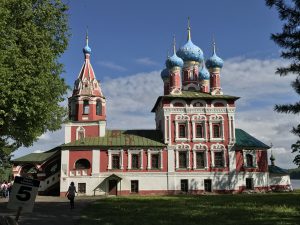 After that bit of fun, we were admitted to the quite small Church of Demetrius on the Spilled Blood, on the spot where 10-year-old Dmitry was assassinated. The exterior of the place is stunning, not least because of its site so near the water. It’s also beautifully restored and painted, almost like a model of a Russian church. It’s a shame that photographs were not allowed, because this one is not only historically important, but is different in several ways from many of the churches we had been in. it’s quite small, for one thing, and it has a larger fore-court/narthex/ante-chapel than I had seen before. At least, it’s large in comparison to the chapel itself. It was tempting to reach out and touch the bell on the stand in the corner, perhaps hard enough to make it ring, but we resisted.
After that bit of fun, we were admitted to the quite small Church of Demetrius on the Spilled Blood, on the spot where 10-year-old Dmitry was assassinated. The exterior of the place is stunning, not least because of its site so near the water. It’s also beautifully restored and painted, almost like a model of a Russian church. It’s a shame that photographs were not allowed, because this one is not only historically important, but is different in several ways from many of the churches we had been in. it’s quite small, for one thing, and it has a larger fore-court/narthex/ante-chapel than I had seen before. At least, it’s large in comparison to the chapel itself. It was tempting to reach out and touch the bell on the stand in the corner, perhaps hard enough to make it ring, but we resisted.
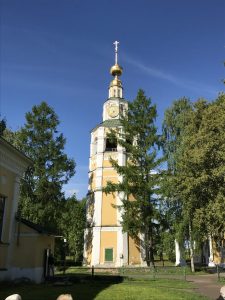 Our next stop was in the surviving bell tower of another church on the Kremlin grounds, where we saw another display of hand-painted lacquered boxes. Of every style and size. I think if I were still teaching music history, I would have bought a nice square one with the Firebird on the top of the box. I had a particularly beautiful one in my hand when I spotted another one, this time with the churches of Kizhi Island on it. I’m afraid it came home with me and is on my desk now.
Our next stop was in the surviving bell tower of another church on the Kremlin grounds, where we saw another display of hand-painted lacquered boxes. Of every style and size. I think if I were still teaching music history, I would have bought a nice square one with the Firebird on the top of the box. I had a particularly beautiful one in my hand when I spotted another one, this time with the churches of Kizhi Island on it. I’m afraid it came home with me and is on my desk now.
We had time after the tour ended to just walk around town a while, so Judy and I headed out looking for a drug store or pharmacy to pick up a couple of things. We struck out on that, but we did have a good time looking through a small grocery store. As we had been told to expect, there were sample sizes of caviar jars on display—empty. If a customer wanted black caviar, they indicated the size they wanted and the caviar was fetched from a locked cabinet or safe. it was also fun to see how many American brands we saw on display, none more amusing than in the pet food section. I’d never expected to see Whiskas and Dentastix on shelves in Russia, with only the brand name in Roman letters, but there they were.
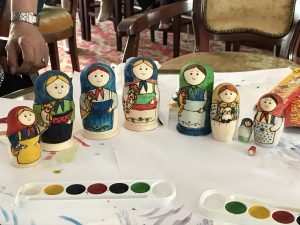 After lunch we had a rather long ride along the Volga and into the Volga-Baltic Canal. That could have been boring as we waited for the final history “lecture,” this one a Q&A session. The option we had was to join a session devoted to painting matryoshka dolls. You know those nesting dolls made of wood and brightly painted? That’s what the cruise directors had planned for us. I decided against doing it at first, but in the end I joined Judy and we both got started putting water colors on the outer doll of a set of five. We sat with two women from California, we all had a ball, and in the end we not only had painted several of our five dolls, we decided to bring them home. I’m not going to tell you which of these are actually ours, but they’re there in the lineup.
After lunch we had a rather long ride along the Volga and into the Volga-Baltic Canal. That could have been boring as we waited for the final history “lecture,” this one a Q&A session. The option we had was to join a session devoted to painting matryoshka dolls. You know those nesting dolls made of wood and brightly painted? That’s what the cruise directors had planned for us. I decided against doing it at first, but in the end I joined Judy and we both got started putting water colors on the outer doll of a set of five. We sat with two women from California, we all had a ball, and in the end we not only had painted several of our five dolls, we decided to bring them home. I’m not going to tell you which of these are actually ours, but they’re there in the lineup.
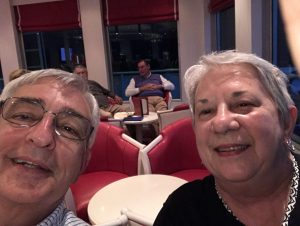 The day ended with our entry into the Moscow-Volga canal, and I had one of my last chances to watch two cruise ships enter a lock and float up 30 feet or so before exiting the other end. I have no idea why watching this process intrigues me so, but I never tire of looking back and forth between the two gates, watching the water level rise or fall, and then watching the gates again before we exit the other end of the lock. Maybe it was all the time I spent as a child playing in the mud and building little dams in the springs around Cook Hill. Or maybe it’s just because I like really big toys. Either way, I was entertained for quite a while before and during dinner, before Judy and I headed up to the Katarina Bar for our night-cap.
The day ended with our entry into the Moscow-Volga canal, and I had one of my last chances to watch two cruise ships enter a lock and float up 30 feet or so before exiting the other end. I have no idea why watching this process intrigues me so, but I never tire of looking back and forth between the two gates, watching the water level rise or fall, and then watching the gates again before we exit the other end of the lock. Maybe it was all the time I spent as a child playing in the mud and building little dams in the springs around Cook Hill. Or maybe it’s just because I like really big toys. Either way, I was entertained for quite a while before and during dinner, before Judy and I headed up to the Katarina Bar for our night-cap.

